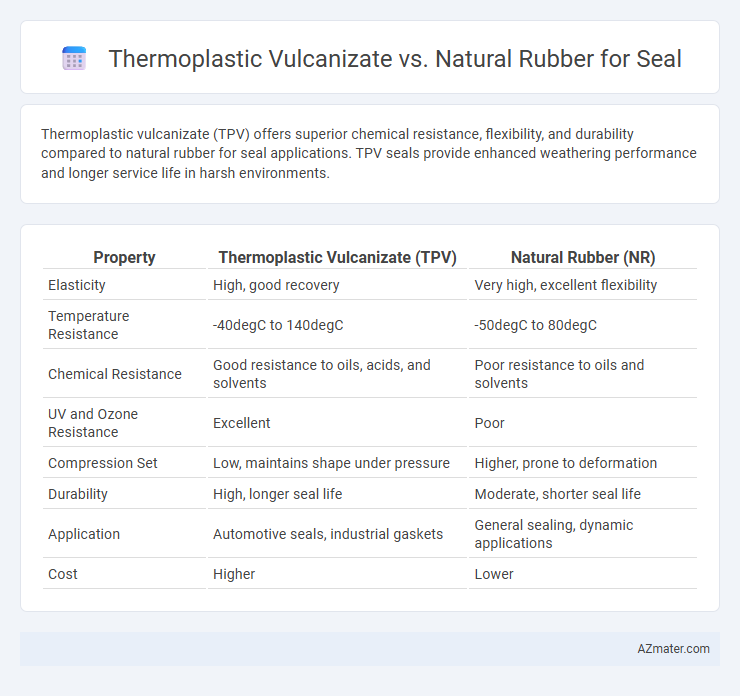Thermoplastic vulcanizate (TPV) offers superior chemical resistance, flexibility, and durability compared to natural rubber for seal applications. TPV seals provide enhanced weathering performance and longer service life in harsh environments.
Table of Comparison
| Property | Thermoplastic Vulcanizate (TPV) | Natural Rubber (NR) |
|---|---|---|
| Elasticity | High, good recovery | Very high, excellent flexibility |
| Temperature Resistance | -40degC to 140degC | -50degC to 80degC |
| Chemical Resistance | Good resistance to oils, acids, and solvents | Poor resistance to oils and solvents |
| UV and Ozone Resistance | Excellent | Poor |
| Compression Set | Low, maintains shape under pressure | Higher, prone to deformation |
| Durability | High, longer seal life | Moderate, shorter seal life |
| Application | Automotive seals, industrial gaskets | General sealing, dynamic applications |
| Cost | Higher | Lower |
Introduction to Seal Materials
Thermoplastic vulcanizate (TPV) offers enhanced chemical resistance, elasticity, and temperature durability compared to natural rubber, making it a preferred choice for advanced seal applications. Natural rubber exhibits excellent flexibility and abrasion resistance but is limited by lower resistance to oils, chemicals, and extreme temperatures. Selecting between TPV and natural rubber depends on specific environmental conditions and performance requirements of sealing components.
Overview of Thermoplastic Vulcanizate (TPV)
Thermoplastic Vulcanizate (TPV) is a high-performance elastomer combining the elasticity of vulcanized rubber with the processability of thermoplastics, making it ideal for seal applications requiring durability and flexibility. TPV offers superior resistance to chemicals, UV exposure, and temperature extremes compared to natural rubber, enhancing seal longevity in harsh environments. Its recyclability and ease of molding reduce production costs while maintaining excellent compression set and flexibility, outperforming traditional natural rubber seals.
Understanding Natural Rubber Properties
Natural rubber exhibits excellent elasticity, resilience, and tear resistance that make it ideal for seals requiring flexibility and durability under cyclic loading. Its superior tensile strength and low compression set ensure reliable sealing performance in dynamic applications and harsh environmental conditions. Compared to thermoplastic vulcanizates, natural rubber offers better abrasion resistance and higher strain tolerance, essential for maintaining seal integrity over long-term use.
Key Differences: TPV vs Natural Rubber
Thermoplastic vulcanizates (TPV) offer superior chemical resistance, flexibility, and weatherability compared to natural rubber, making them ideal for seals exposed to harsh environments. TPV provides consistent performance over a wider temperature range, with enhanced durability and excellent compression set resistance, while natural rubber excels in elasticity and cost-effectiveness for applications requiring high resilience. The key differences lie in TPV's thermoplastic processing advantages and long-term stability versus natural rubber's superior tensile strength and biodegradability.
Mechanical Strength and Durability Comparison
Thermoplastic vulcanizate (TPV) exhibits superior mechanical strength compared to natural rubber (NR), with higher tensile strength and resistance to deformation under stress, making it ideal for seals subjected to dynamic loading. TPV offers enhanced durability due to its excellent resistance to heat, oils, and weathering, whereas natural rubber tends to degrade faster in harsh environmental conditions. The improved resilience and long-term performance of TPV seals often result in lower maintenance costs and extended service life in industrial applications.
Chemical and Weather Resistance
Thermoplastic vulcanizates (TPVs) exhibit superior chemical resistance compared to natural rubber, maintaining integrity against oils, solvents, and acids commonly encountered in sealing applications. TPVs also offer enhanced weather resistance, resisting UV radiation, ozone, and extreme temperature fluctuations more effectively than natural rubber, which tends to degrade and crack under prolonged environmental exposure. These properties make TPVs a more durable choice for seals in harsh chemical and outdoor environments.
Processability and Manufacturing Differences
Thermoplastic vulcanizates (TPVs) offer superior processability compared to natural rubber due to their ability to be melted and reshaped multiple times, enabling efficient injection molding and extrusion. Natural rubber requires vulcanization, a chemical curing process that is time-consuming and limits design flexibility during manufacturing. TPVs provide faster cycle times and lower energy consumption in production, making them more cost-effective for high-volume seal manufacturing.
Cost Analysis and Economic Considerations
Thermoplastic vulcanizate (TPV) offers a lower long-term cost compared to natural rubber due to its superior durability, chemical resistance, and recyclability, reducing replacement frequency and material waste. Natural rubber exhibits lower initial material expenses but incurs higher maintenance and replacement costs due to its susceptibility to aging, ozone, and chemical degradation. Economic considerations favor TPV for large-scale or high-performance seal applications where lifecycle cost efficiency outweighs upfront savings.
Application Suitability in Seal Industries
Thermoplastic vulcanizate (TPV) offers superior chemical resistance and excellent aging properties, making it ideal for seals used in harsh industrial environments such as automotive and chemical processing. Natural rubber excels in applications requiring high elasticity and resilient compression set, often preferred for seals in HVAC systems and fluid handling due to its flexibility and excellent sealing under dynamic conditions. TPV's ease of processing and recyclability provide cost-effective advantages for large-scale production, while natural rubber's natural resilience supports durable sealing in moderate temperature ranges.
Conclusion: Choosing the Right Material for Seals
Thermoplastic vulcanizate (TPV) offers superior chemical resistance, flexibility, and durability compared to natural rubber, making it ideal for seals exposed to harsh industrial environments. Natural rubber provides excellent elasticity and cost-effectiveness for low-temperature or less demanding sealing applications. Selecting the right material depends on operating conditions, with TPV preferred for long-term performance and natural rubber suitable for moderate use and budget constraints.

Infographic: Thermoplastic vulcanizate vs Natural rubber for Seal
 azmater.com
azmater.com